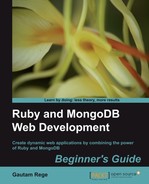class Delta include Mongoid::Document include Mongoid::Versioning field :name, type: String end
Let's see it in action:
irb> a = Delta.create
=> #<Delta _id: 4f22f748fed0eb9e6e000003, _type: nil, version: 1, name: nil>
irb> a.name = "First"
=> "First"
irb> a.save
=> true
irb> a
=> #<Delta _id: 4f22f748fed0eb9e6e000003, _type: nil, version: 2, name: "First">
irb> a.name = "Second"
=> "Second"
irb> a.save
=> true
irb> a
=> #<Delta _id: 4f22f748fed0eb9e6e000003, _type: nil, version: 3, name: "Second">
irb> a.revise!
=> true
irb> a
=> #<Delta _id: 4f22f748fed0eb9e6e000003, _type: nil, version: 4, name: "Second">
When we included the Versioning module:
The model is now configured to update the version every time the object is saved. When it's created the first time, notice that the version number is set:
irb> a
=> #<Delta _id: 4f22f748fed0eb9e6e000003, _type: nil,
version: 1,
name: nil>
Every time, the object is saved, the version number is incremented and the versioned attributes (that is, all the fields in the document) get saved inside the versions embedded object's array and the version is incremented.
If we want to update the version without any changes, we can use the revise! method.
Tip
Some more fancy stuff with versioning
If you want to save the document but don't want to version it, use the versionless method. This temporarily disables versioning, for example, object.versionless(&:save).
If you want to see changes made to the object, use the :previous_changes method.
If you want to see the versioned objects, use the :versions method.
Notice, that we mentioned cyclic relationship. We saw this earlier in the embedded relations. For versioning, we need exactly one parent and many child documents of the same class embedded in it!
- Which of the following is the incorrect way of accessing the
titlefield of theBookmodel?- a.
Book.first.title. - b.
Book.first[:title]. - c.
Book.first.read_attribute(:title). - d.
Book.first.get_title.
- a.
- When a field is localized, how is that field stored in the database?
- a. As an embedded object.
- b. As an array.
- c. As a hash.
- d. As a comma-separated string.
- What does the
cascaded_callbacksoption do?- a. Enables callback invocation on the embedded object.
- b. Cascaded deletes the callbacks in children.
- c. Enables callback invocation for parent object.
- d. Disables callback invocation on the embedded object.
- What would
recursively_embeds_manyin theAuthormodel not do?- a. Add a cyclic
embeds_manyrelation forAuthor. - b. It creates an array of embedded objects called
child_authors. - c. Add a field called
parent_authorin theAuthormodel. - d. Adds a field called
author_countin theAuthormodel.
- a. Add a cyclic
- Why do we need to specify the
embedded_inrelation in the embedded Model?- a. Mongoid needs to index this embedded object.
- b. All documents are
Mongoid::Document. This is the only way Mongoid knows that the document is embedded in another document. - c. Mongoid needs to store this in the embedded collection.
- d. When
Mongoid::EmbeddedDocumentis specified, we do not need this relation, otherwise we need it.
